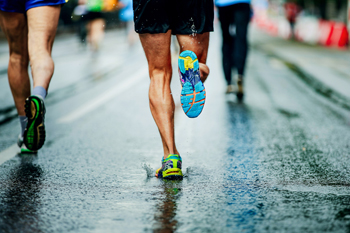
Running injuries affecting the feet, toes, and ankles can often be avoided with proper precautions. Gradually increasing running intensity and mileage helps prevent stress on the foot and ankle structures, reducing the likelihood of conditions like Achilles tendonitis and stress fractures. Wearing well-fitted running shoes with adequate support and cushioning minimizes excessive pressure on the forefoot and heel, helping to prevent plantar fasciitis and blisters. Paying attention to form, such as avoiding overstriding, can decrease the impact force on the feet and ankles. Strengthening the lower leg and foot muscles improves stability, which reduces the risk of ankle sprains. Cross-training with low-impact activities allows the feet and ankles to recover while maintaining fitness. Runners should also listen to their body and rest if pain develops to avoid worsening an injury. A podiatrist can assess your running-related foot injury, recommend custom orthotics, and provide the appropriate treatment to help you maintain healthy feet. If you have injured your foot, toe, or ankle from running, it is suggested that you schedule an appointment with a podiatrist for an exam and treatment.
All runners should take extra precaution when trying to avoid injury. If you have any concerns about your feet, contact one our of podiatrists of The Foot and Ankle Specialists. Our doctors will treat your foot and ankle needs.
How to Prevent Running Injuries
There are a lot of mistakes a runner can make prior to a workout that can induce injury. A lot of athletes tend to overstretch before running, instead of saving those workouts for a post-run routine. Deep lunges and hand-to-toe hamstring pulls should be performed after a workout instead of during a warmup. Another common mistake is jumping into an intense routine before your body is physically prepared for it. You should try to ease your way into long-distance running instead of forcing yourself to rush into it.
More Tips for Preventing Injury
- Incorporate Strength Training into Workouts - This will help improve the body’s overall athleticism
- Improve and Maintain Your Flexibility – Stretching everyday will help improve overall performance
- “Warm Up” Before Running and “Cool Down” Afterward – A warm up of 5-10 minutes helps get rid of lactic acid in the muscles and prevents delayed muscle soreness
- Cross-Training is Crucial
- Wear Proper Running Shoes
- Have a Formal Gait Analysis – Poor biomechanics can easily cause injury
If you have any questions, please feel free to contact our offices located in Houston and Deer Park, TX . We offer the newest diagnostic and treatment technologies for all your foot care needs.
